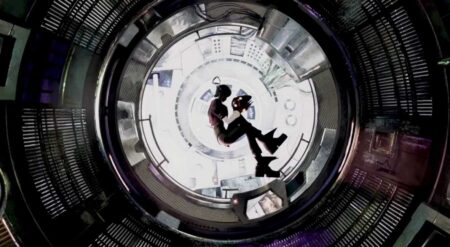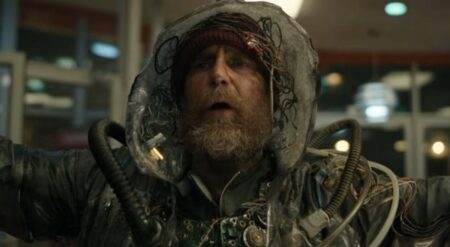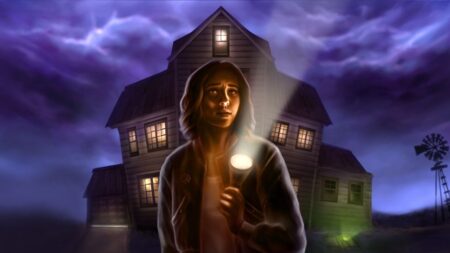We spoke with four of the leads behind Magic: The Gathering and its big upcoming crossover, the Final Fantasy set.
It’s easy to say that the upcoming crossover between Magic: The Gathering and Final Fantasy is thunderously popular. Even setting aside how it’s already one of the card game’s best-selling sets, the giant signs around PAX East in Boston, Massachusetts, made the crossover proportions feel titanic. The likes of Kefka, Y’shtola, and more greeting you as you walked in each day, emblazoned with Magic logos, ensured the crossover was on everyone’s mind going into Saturday’s panel.
Today, the team behind Magic: The Gathering’s Final Fantasy set revealed even more details about the cards coming in the new set on June 13. Ahead of that, I got the chance to sit down with four architects behind the crossover: Dillon Deveney, Principal Game Designer and narrative lead; Daniel Holt, Senior Game Designer working on the Commander decks; Zakeel Gordon, Executive Producer for tabletop Magic and product architect; and Gavin Verhey, Principal Game Designer and set design lead on Final Fantasy.
These four, and the rest of the team at Wizards of the Coast, had one task with the Final Fantasy set. Take all that Final Fantasy is, across decades of numerous games and characters, and distill them into one set.
“I think from our perspective, there was never a doubt in our minds it was going to work,” said Verhey. The designer told me the similarities between Final Fantasy and Magic: The Gathering, especially some of the high fantasy vibes, made it easy to see how the two brands could meld. The far larger concern, as Verhey outlines, is how the team could take 16 mainline Final Fantasy games — the bounds they set for adaptation — and figure out what they were going to include, who, and how.
“You could take any Final Fantasy game, even the first one, and do a whole Magic set based on it if you wanted to,” said Verhey.
“For me, when I’m thinking about Final Fantasy as a set, when we were ready to do it, it’s like the next natural progression of Universes Beyond,” said Deveney. “Everything that we were doing up until then, we were getting our feet wet, we were learning, we were adapting. We were coming up with new processes. We were getting smarter and better. And then when Final Fantasy was here, it was like, we need to be on it, to take this on, and it’s where we wanted to go. It’s where a lot of people, right here, wanted to go.
“So when we got the green light, it was like, this is our chance to communicate, not only to other Wizards, but to like the world of, this is where we’d like to take Universes Beyond for now,” Deveney continued. “Hopefully this sets the template of like, this is what you can expect, the heart and soul and passion of every single set, and every single thing we work on, we put so much time into it, and this is kind of like the big reveal party for that. So it was kind of a way to kind of all take the next step of where we want to take UB. Final Fantasy is the way to do it.”
The MTG Final Fantasy Set is all about authenticity.
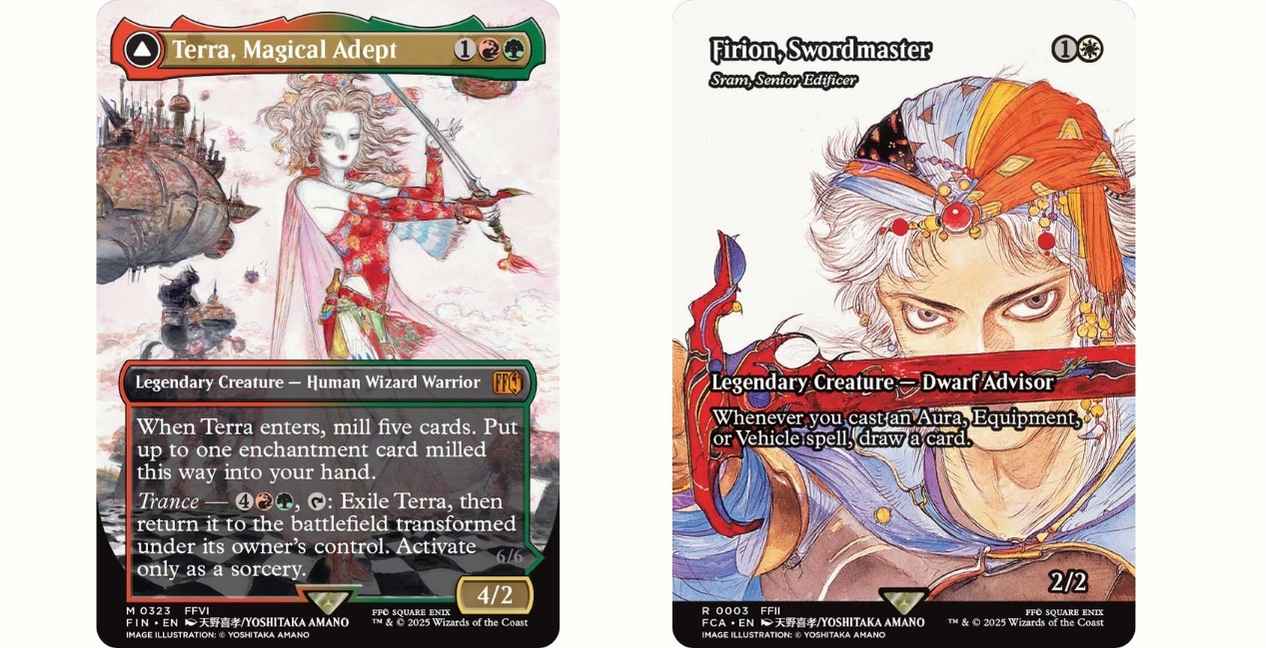
Distilling Final Fantasy, even just from its main trunk of games, into a card set meant gaining familiarity with the games. Luckily, as the designers told me, several were already quite familiar with Final Fantasy. Others put in hours to acquaint themselves with parts they hadn’t checked out yet; Holt told me about the hundreds of hours he put into Final Fantasy XIV, for example, to familiarize himself with the story of the critically acclaimed MMORPG.
In some ways, it might have felt like years of playing video games paying it off. “There’s something someone told me once, which was, everything you do in life is training for something else, you just don’t know it yet. And I never felt that more with this set,” said Verhey. “It’s like, I did not think that those hours playing a Final Fantasy were going to be meaningful, but dad, you were wrong!”
Jokes aside, there was quite a bit to piece apart, look into, and make decisions over which characters make the cut or not. The Magic team mentioned guidance from Square Enix and the Final Fantasy team on multiple fronts. While the Final Fantasy team is very specific about each game and the context in which it’s shown, the Magic team also got to dig into history in surprising ways.
“When it came to at least Final Fantasies 1 through 6, we had a lot of freedom to explore how to take characters who were only ever seen in pixel art or manual art, and then bring them up to the hyper-detail of Noctis in Final Fantasy XV,” said Deveney.
How did the Magic team decide what elements of the video games made it into the Final Fantasy Set?
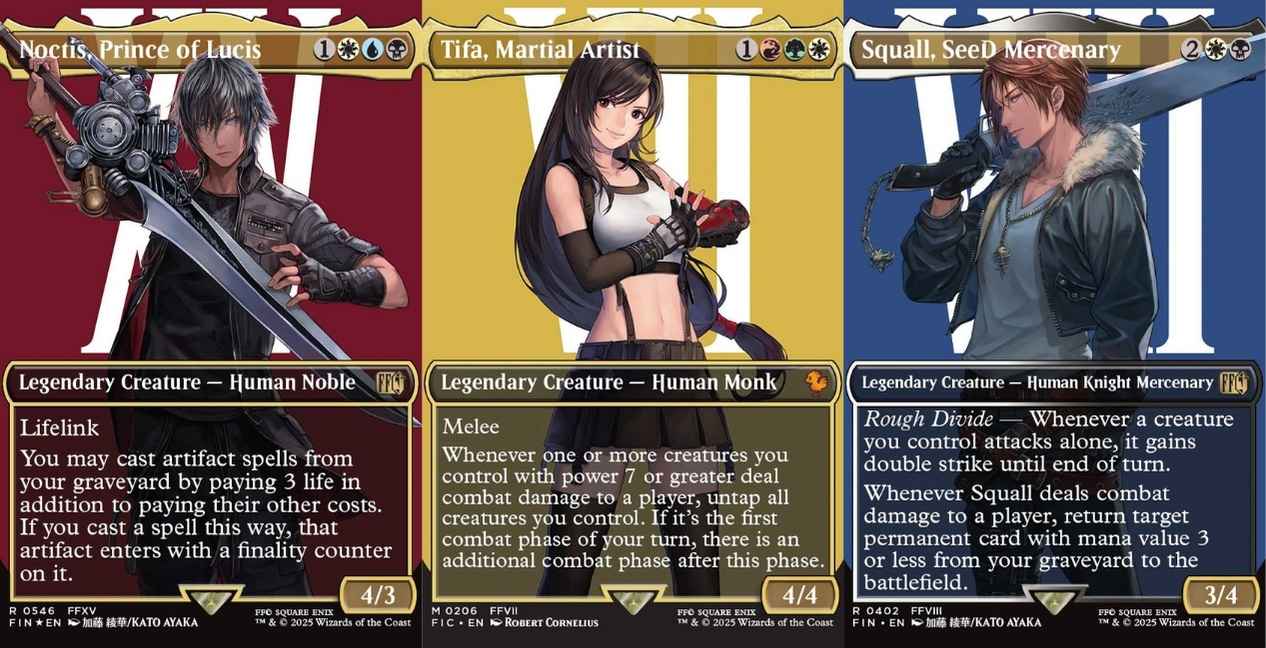
That does mean, in some cases, examining tiny pixels or barely referenced items and considering their prospects as a card. If it suits the purposes of what the Magic team wanted to make with the set, then even lesser-known references could be useful.
“I messaged [Deveney] almost every day for a while, when I was on [Final Fantasy VI] deck, I’m like, ‘Hey is there something that represents this?’ Here’s a tiny pixel item, I was like,
‘is that enough? Can we make a circle?'” said Holt.
As Holt explained, the teams working on the main set and the Commander deck could also collaborate to show different versions of the same character. “We can show the Red/White version of that character here, they need to be this point in time,” said Holt. “Let’s show their mono-Black version in the main set, where they do maybe an evil thing.”
Ultimately, the two brands had to find the best way to make both ends meet. “I would say we had a lot of liberty in the exploration, but it would still come back to that title owner, that team, and they would give us feedback to align it to the overall IP’s goals,” Deveney told me.
“We don’t necessarily need to remake those characters to fit within Magic,” said Gordon. “Magic’s version of those characters just exist in the designs that we’re making, like, as a mechanical game. So I think all of the work we put in over the years, to make sure that the character felt right in the context of the world that they represent, the micro-IP that exists within the Final Fantasy brand, just leads to a better experience and better product for the fans.”
The selection criteria and actually creating the cards did come down to a few factors. The Magic team told me how they stumbled onto the same “expectations and processes and throughlines” that the Final Fantasy team works through for creating games; questions of what to do with the world, with summons, and with familiar characters like chocobos.
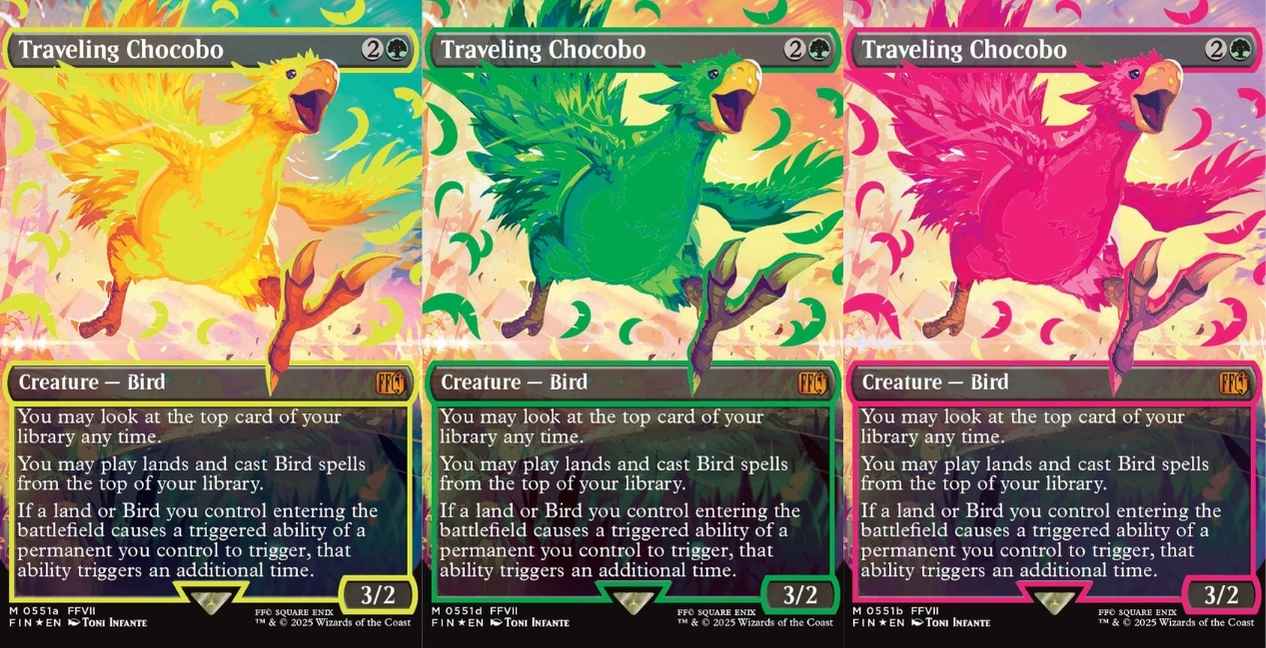
When it comes to iconic characters, like Cloud or Terra, you have to wonder how you put it all on a single card. Deveney said it came down to the evergreen expectation of a character’s power set and what “snapshot” moment they wanted to spotlight.
“That’s either the coolest, most cinematic [moment] right before the final boss fight, the first time we ever met the protagonist or character ever, or that really broken build that everyone always does, and it’s a community moment that we want to make sure like, we got that in there,” said Deveney.
I asked about Final Fantasy XIV in particular, considering not only how much XIV exists but also how those characters change over the course of expansions. The Magic team had to, once again, draw a line in the sand. Major characters, like the Scions, would be present in “their most up-to-date version as of [Final Fantasy XIV: Endwalker].” It was the expansion that lined up with the development timeline, and where efforts would be focused. But also, if a character was mostly important in a previous expansion or prior content, that character would be shown in their best moment.
“How do we possibly show 10 years worth of a character on a single piece of cardboard?” said Deveny. “So let’s pick the thing that most people are going to know, or if they were only in that one expansion, the moment they remember of that character.”
Diving into the Final Fantasy Set mechanics and Summons.
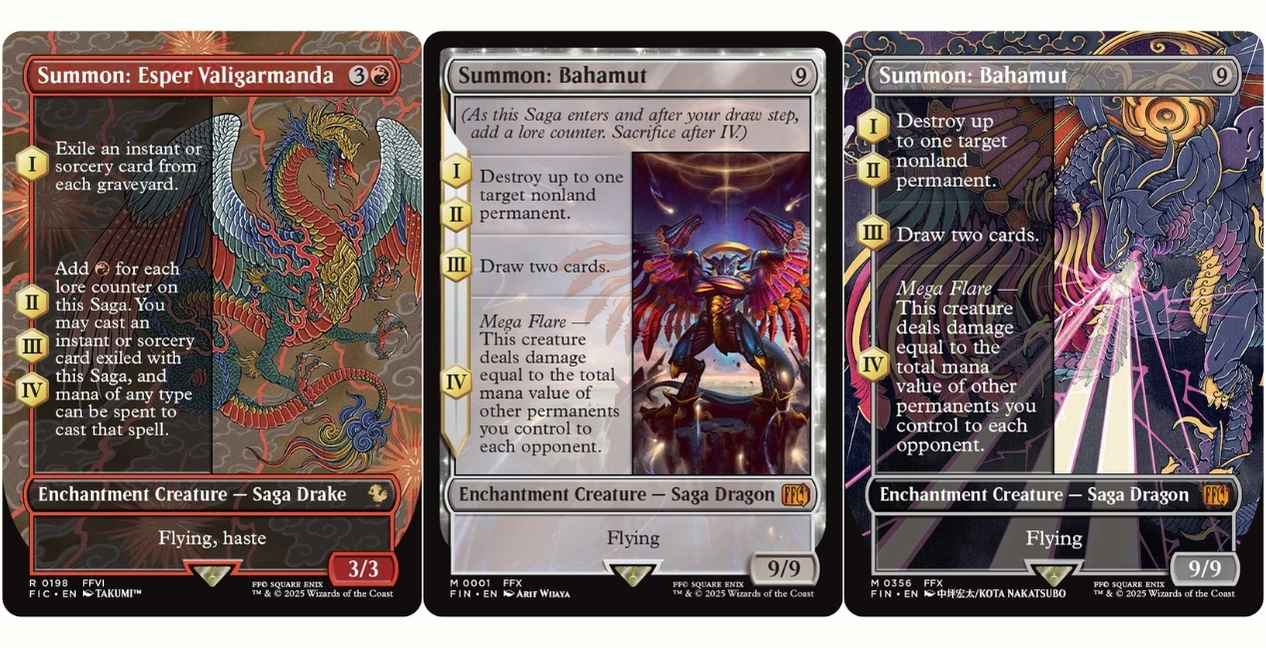
On a mechanical level, the Magic team is working with some interesting ideas for the Final Fantasy set. Core tenets of Final Fantasy, like the job system and summons, are not just referenced but established as functional pillars. Summoning in particular, and the mechanics of a “Saga Creature,” came about while trying to figure out how to represent Final Fantasy’s powerful, impactful summons.
Verhey told me the team worked with some ideas around vanishing, which would handle the temporary nature of summons, but it felt like a downside. Then, one of the Magic team members suggested the idea of Saga Creatures, and it just clicked into place. “It was pretty clear, pretty fast, that this was going to be a core mechanic of the set,” said Verhey.
Other parts of Final Fantasy gave the Magic: The Gathering crew at Wizards some fun ways to tie existing Magic mechanics into Final Fantasy. “The flashbacks in this set are flashbacks in the actual game,” Verhey told me. Cards like Hildibrand can reflect the ever-returning nature of XIV’s adventuring gentleman.
They also provide ways of telling the stories of Final Fantasy. Deveney described the card design behind Cecil, Final Fantasy IV‘s Dark Knight-turned-Paladin, and the internal struggle that defines his journey. Using those concepts, the team crafted an actual mechanic around his transformation, helping to play the story out on the table.
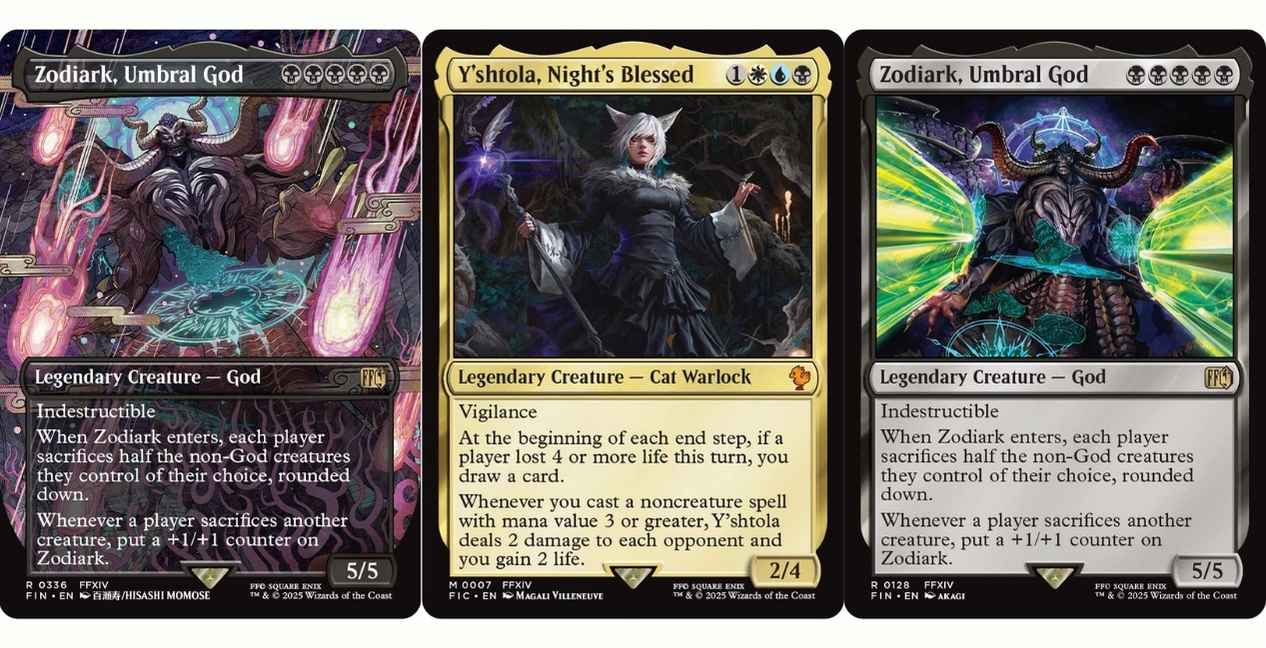
Sometimes, it’s also about providing something special for someone’s favorite character. Verhey told me the team went to Japan to playtest with the Final Fantasy team, and he talked with a developer who worked on Final Fantasy IX — which, as it happens, is also Verhey’s favorite Final Fantasy.
“I’m like, ‘oh who’s your favorite character, or one of your favorite characters?'” said Verhey. “And he’s like, ‘well, one of my favorites is Queen Brahne, but no one ever does anything with her, she’s not a character anyone ever does anything with.’ And I went over to our deck, I flipped through, and I’m like, ‘you mean this one right here?'”
There are still unrevealed cards that dig deeper into both the big moments and particular favorites. Still, it’s certainly clear that there’s a solid degree of love for the source material going into Magic’s Final Fantasy set. And with fans so eager to play, some might find that intimidating. The Magic team had a different way to describe it, though.
“”I have never felt intimidated by it,” said Verhey. “But the thing that I have had, I think all four of us have had, is confidence in it.”
This crossover feels like a big step for both Magic: The Gathering’s crossovers with Universes Beyond, and for Final Fantasy in reaching even further to more players. It might be a lot to handle for some. But it sounds like, for the main architects behind this collab, it was something they were ready to handle.
“A couple of months ago, someone in the building asked, ‘How long did it take you to work on the set?'” said Gordon. “And the real answer is, you know, we made it in five years. But in a lot of ways, it kind of took us our whole lives to make this set. I’ve kind of been making this for the past more-than-30 years.”
Magic: The Gathering’s Final Fantasy set will hit retail on June 13, 2025.

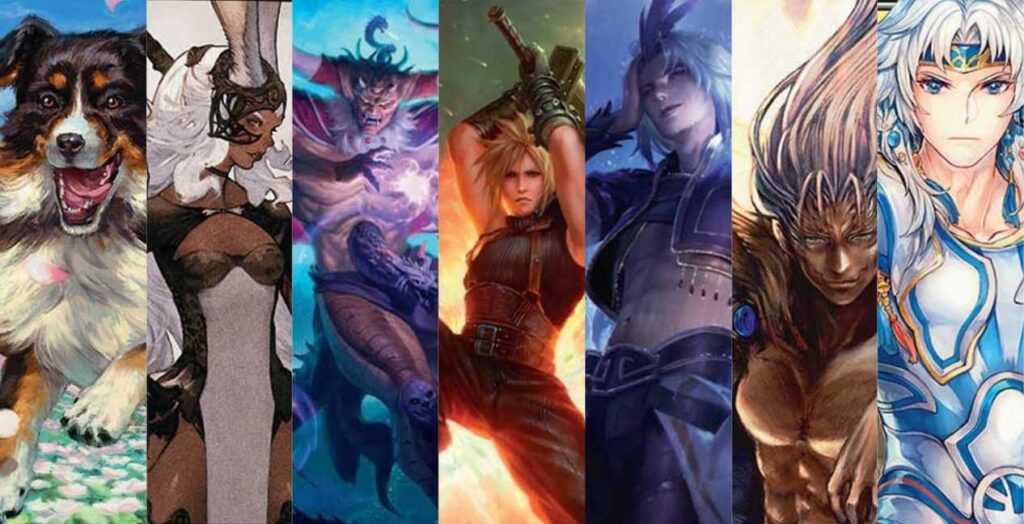

![[EXCLUSIVE] Palia Devs Dive Into Winterlights, New Tints, Lunar Paths, And More From Upcoming Patch Palia Winterlights Patch](https://butwhytho.net/wp-content/uploads/2025/12/Palia-Winterlights-But-Why-Tho-450x247.jpg)

